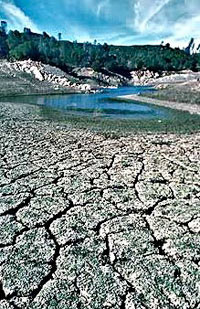
|  |  |  News Around the Republic of Mexico News Around the Republic of Mexico  
Mexico City Battles Water Crisis with Taxes, Pleas
 Patrick Rucker - Reuters Patrick Rucker - Reuters
go to original
January 04, 2010


| | Mexico City, one of the world's biggest cities at 20 million people, has long struggled with a lack of water but the crisis worsened this year due to drought that has left reservoirs at record lows. |  |
Valle de Bravo, Mexico - Lake Avandaro has long been the emblem of leisure in this wealthy, colonial town west of Mexico City, but the capital sucked it half-dry last spring.

Ever thirstier, Mexico City diverted tonnes of water from the lake to the capital, putting the quaint village of Valle de Bravo in jeopardy as a popular weekend vacation spot for the rich.

Water skiers and boaters had to dodge emerging rocks as the lake level dropped to half its normal volume.

"I was born here and I have never seen it at that level," said Carlos Gonzalez, 33, manager of the floating Los Pericos restaurant that was in danger of resting on the lakebed just a few months ago.

Mexico City, one of the world's biggest cities at 20 million people, has long struggled with a lack of water but the crisis worsened this year due to drought that has left reservoirs at record lows.

Water authorities increasingly turned to Lake Avandaro, nestled in a picturesque wooded area, to satisfy demand. Outrage from wealthy residents halted the worst of the draining and a deal was eventually reached to keep the lake level at 75 percent.

Mexico City lawmakers in December agreed to increase water tariffs for all users in 2010 and cut generous subsidies, but that hard-fought change may not be enough.

Sudden cuts in the water supply are frequent and many residents know their water by the color it leaves the spout.

"It comes out like tamarind juice and then yellow, yellow, yellow," said Maricela Martinez who shares a small house with her extended family in the poor Iztapalapa neighborhood.

"At times it comes out worse - putrid like dead flowers thrown away," she said.

The Martinez family have long made allowances for poor service by having drinking water delivered in 20-liter (5.28 gallon) jugs while the liquid that comes from the pipes is only fit for houseplants, they said.

Mexico City's wealthiest residents will pay more than three times as much for their water service as the city's poorest under the new tax structure. Annual water costs for a wealthy family still should not top 515 pesos ($40) a year, local media reports.

The new tax structure will eliminate "ridiculously low" levies and represents a first step to creating a self-sustaining system, said Ramon Aguirre, director of Mexico City's water department.

"The clear path to resolving this problem is in higher tariffs," Aguirre said.

Yet despite the higher levies, water is still relatively cheap compared to other capital cities around the world. Wealthier Mexico City residents use as much as 300 liters of water per day, half again the rate set by residents in European capitals, said Gustavo Saltiel, a World Bank development expert based in Mexico.

WASTED WATER

Leaks and theft mean nearly 40 percent of Mexico City water is lost before it reaches the tap and only half of what is left is metered. Officials are in a desperate battle to serve the 20 million residents and the business community at a time of declining rainfall.

"Business as usual is not sustainable," said Saltiel, who is advising the Mexican government on its water crisis. "Can you bring water from far away? Yes, but how much? And how much of this scarce resource is available?"

A huge lake system that once covered Mexico City's vast urban plain and nurtured a vibrant Aztec civilization has long vanished due to explosive population growth and inordinate water use.

The nearest aquifers are depleted, prompting buildings downtown to sink slowly. Meanwhile, engineers are trying to tap distant waterways.

Officials limited water service to many Mexico City neighborhoods last spring in the face of a dry spell not seen in nearly 70 years. New tariffs and a public awareness campaign should help curtail demand so that such drastic steps are not needed next year, said Aguirre.

Ironically, the capital often suffers from a deluge of water. In the summer rainy season, downpours hit the city almost nightly for several months. But much of the rain is not captured and inadequate drainage means that the city often chokes.

A busted sewer pipe in the outskirts of the city created a river of flood water that smashed cars, closed subway stations and killed an elderly couple in September. A later downpour blocked access to the city's main refuse dump, backing up garbage for days.

(Reporting by Patrick Rucker; research by David Cutler, editing by Philip Barbara)
|

 |
|  |



